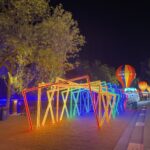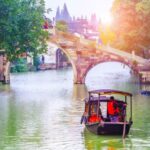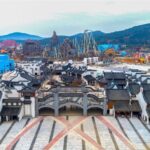Shajiabang Scenic Area is located more than 10 kilometers south of Changshu City and on the north side of Yangcheng Lake. It is famous for the Peking Opera model play ‘Shajiabang’, and the TV series ‘Shajiabang’ was also filmed here. In the scenic area, you can see the scenes in the play. You can also take a cruise ship to go deep into the reed marshes and enjoy the beautiful wetland scenery. In summer, lotuses are in full bloom in the scenic area and can be enjoyed.
The gate of Shajiabang is in the southwest corner. Passing through the commemorative square with statues of A Qing Sao and Guo Jianguang, the instructor of the New Fourth Army, first visit the Shajiabang Revolutionary History Memorial Hall. The memorial hall belongs to the periphery of the main scenic area. After learning about the anti-Japanese history of Shajiabang here, when you play again, you will have a deeper understanding of the revolutionary careers of A Qing Sao and Guo Jianguang. Walking eastward past the Tiankai Bojing Memorial Archway, you will come to the main scenic area of Shajiabang. What appears in front of you is the typical small water town in the south of the Yangtze River, Hongshi Folk Culture Village. In many museums in the small village, such as the root carving museum and the wedding custom museum, you can learn about local folk customs. Walking northward past the Yinhu Corridor is the cruise ship dock. You can take a black-awning boat to the reed maze or take a boat to the Hengjing Old Street Film and Television Base. The reed maze is on the south side of Hongshi Folk Culture Village. There are distinctions between the water maze and the land maze. The water maze is taking a boat, and the land maze is walking on the plank road paved on the water surface. It is recommended to take a boat tour of the reed maze because this is the essence of the scenic area. The reeds here are taller than people. In spring and summer, it is like a green tent on the water, full of greenery; in autumn and winter, the reeds turn yellow, the reed flowers are flying, and it is desolate. In those days, A Qing Sao and the local people hid the injured New Fourth Army in such reed marshes for treatment and周旋 with the Japanese army. Taking a boat and traveling in the narrow waterway, with the breeze blowing gently and the reeds rustling, you can also see many egrets. Then listen to the boatman sing a song in the soft Wu dialect. The feeling of ‘Jiangnan’ is so real. After the cruise ship makes a circle and returns not far from the original boarding dock, go northeast to the Hengjing Old Street Film and Television Base. This is the ancient town of Shajiabang restored for the filming of the TV series ‘Shajiabang’. There are wine workshops, dyeing workshops, bamboo ware shops, embroidery rooms, blacksmith shops, and weaving workshops. You can visit the Jiangnan Agricultural Custom Museum displaying rural production and living utensils. Climb to the upstairs of the Diao Zhai Courtyard (the Fifth Army Command of the Loyal National Salvation Army) of the traitor Diao Deyi in the play and overlook the Hengjing Old Street. At the northern end of the old street, there is also a section of city wall built for the needs of filming. To the north of Shajiabang, from east to west, there are scenic spots such as Luhua Village, Wanzhu Island, and National Defense Education Park. The National Defense Education Park displays military aircraft, tanks, cannons, etc., and there are amusement facilities similar to ‘the road of the brave’ such as suspension ring bridges, swing bridges, and suspension bridges for quality expansion. There are many performances to watch in the scenic area. At the ancient stage of Hongshi Folk Culture Village, you can watch Peking Opera ‘Shajiabang’ excerpts such as ‘Struggle with Wits’ from time to time.The traditional stage at the Hengjing Old Street Film and Television Base offers performances of the Peking Opera ‘Sha Jia Bang’ and the Picking Flower Basket show, with performance times varying; on Saturdays and Sundays, there are also traditional wedding customs performances available, with times not fixed. Due to the character Ah Qing’s wife who opened a teahouse named ‘Chun Lai’ in the model Peking Opera ‘Sha Jia Bang’, most teahouses in the scenic area are named after it.
The original Chun Lai Teahouse is located in the Reed Maze, the second generation is at the main entrance of the scenic area, and the third generation is in the Red Stone Folk Culture Village. After enjoying the opera, one can visit a teahouse for a pot of tea and reminisce about the wits of Ah Qing’s wife in the teahouse against the cunning Diao De Yi. There are limited dining options within Sha Jia Bang, with the main ones being on Hengjing Old Street where one can taste some local snacks. If planning to spend a longer time within the scenic area, it is recommended to bring some dry food. Fresh sweet reeds (similar to sugarcane) and red water chestnuts in autumn are quite good. Outside the scenic area, there is a row of restaurants in the parking lot, and further south on the Xitai Highway, there are many small wooden houses built over water, where the water bamboo shoots, pumpkin porridge, and clam meat tofu are fresh and delicious. Around Yangcheng Lake, there are many popular places to eat Yangcheng Lake hairy crabs, such as Ba Cheng. Changshu, while benefiting from the reputation of Yangcheng Lake, is not as well-known. Visiting Sha Jia Bang to eat Yangcheng Lake hairy crabs is a ‘different path’, but the crabs are very authentic and taste great. The scenic area is open all year round from 08:30 to 16:30.
Preferential policies include: Children under 6 years old (inclusive) or under 1.4 meters (inclusive) in height enter for free; minors aged 6 to 18 years old (inclusive) with valid identification receive half-price tickets; full-time undergraduate students and below with valid identification receive half-price tickets; seniors aged 70 years old (inclusive) and above enter for free; seniors aged 60 to 70 years old (exclusive) with valid identification receive half-price tickets; active-duty military personnel or retired officers with relevant certificates enter for free; tour bus drivers with A1 or A2 driving licenses issued by the public security department enter for free; disabled people with disability certificates, disabled veterans with revolutionary disability certificates, and disabled police officers with certificates enter for free; severely disabled individuals (first and second level) can have one free companion; retired cadres with retirement certificates issued by the State Council or Central Military Commission enter for free and can bring one family member for free; martyrs’ families with certificates issued by civil affairs departments enter for free; journalists with press cards issued by the State Administration of Radio, Film, and Television or the General Administration of Press and Publication enter for free; labor models with certificates issued by the national, provincial, municipal, and Changshu city governments enter for free; tour guides with tour guide qualification certificates or IC cards, travel agency manager qualification certificates, and training certificates enter for free; residents with valid Changshu Citizen Cards, Changshu Citizen Card Tourism Special Cards, resident ID cards with tourism annual card functions, Suzhou Leisure Annual Cards (Suzhou Tong, Suzhou Citizen Card, Zhuanzhuan Card), and Wuxi Citizen Cards can enter for free during non-peak times; members of the Suzhou Ecological Association with membership cards can enter for free with up to three people (including themselves); members of the Suzhou Wildlife Protection Association with membership cards can enter for free with up to three people (including themselves); collective visits by primary, middle, and high school students to memorial halls are free with prior reservation; local residents with valid identification can enter for free from December 1st to December 7th annually; ‘Changshu City Honorary Citizens’ and ‘Changshu City Honorary Citizens’ with relevant documents can enter for free with up to five people (including themselves); blood donation volunteers with national blood donation awards can enter for free; preferential treatment recipients with Jiangsu Province preferential treatment certificates can enter for free; firefighters with national comprehensive fire rescue team officer certificates, firefighter certificates, retirement certificates, and student certificates can enter for free; Changshu city residents with valid identification can enter with discounted tickets.
Night tour children: those under 90 cm (inclusive) enter for free; those between 90 cm (exclusive) and 140 cm (inclusive) receive half-price tickets.
Additional notes: 1.
Effective May 1st, new project prices for visitors under 4 meters: Hand-Rowed Boats 20 RMB/person, Motorized Boats 15 RMB/person, Electric Carts 10 RMB/person, Live Performances 20 RMB/person, free tickets for infants held in arms, with no adjustments for other groups. Tickets must be purchased at the scenic area’s window.

Free policy for in-park projects (electric carts, live performances, boats): Children under 90 centimeters (not including) are free.









